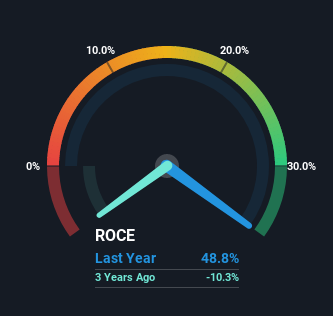Finding a business that has the potential to grow substantially is not easy, but it is possible if we look at a few key financial metrics. Ideally, a business will show two trends; firstly a growing return on capital employed (ROCE) and secondly, an increasing amount of capital employed. Basically this means that a company has profitable initiatives that it can continue to reinvest in, which is a trait of a compounding machine. And in light of that, the trends we're seeing at Saras' (BIT:SRS) look very promising so lets take a look.
Understanding Return On Capital Employed (ROCE)
If you haven't worked with ROCE before, it measures the 'return' (pre-tax profit) a company generates from capital employed in its business. The formula for this calculation on Saras is:
Return on Capital Employed = Earnings Before Interest and Tax (EBIT) ÷ (Total Assets - Current Liabilities)
0.49 = €1.1b ÷ (€4.2b - €2.0b) (Based on the trailing twelve months to March 2023).
So, Saras has an ROCE of 49%. That's a fantastic return and not only that, it outpaces the average of 16% earned by companies in a similar industry.
See our latest analysis for Saras

In the above chart we have measured Saras' prior ROCE against its prior performance, but the future is arguably more important. If you'd like, you can check out the forecasts from the analysts covering Saras here for free.
SWOT Analysis for Saras
- Earnings growth over the past year exceeded the industry.
- Debt is not viewed as a risk.
- Dividends are covered by earnings and cash flows.
- Dividend is in the top 25% of dividend payers in the market.
- Expensive based on P/E ratio and estimated fair value.
- SRS' financial characteristics indicate limited near-term opportunities for shareholders.
- Annual earnings are forecast to decline for the next 3 years.
How Are Returns Trending?
The trends we've noticed at Saras are quite reassuring. Over the last five years, returns on capital employed have risen substantially to 49%. Basically the business is earning more per dollar of capital invested and in addition to that, 37% more capital is being employed now too. The increasing returns on a growing amount of capital is common amongst multi-baggers and that's why we're impressed.
On a side note, Saras' current liabilities are still rather high at 48% of total assets. This can bring about some risks because the company is basically operating with a rather large reliance on its suppliers or other sorts of short-term creditors. While it's not necessarily a bad thing, it can be beneficial if this ratio is lower.
What We Can Learn From Saras' ROCE
A company that is growing its returns on capital and can consistently reinvest in itself is a highly sought after trait, and that's what Saras has. Astute investors may have an opportunity here because the stock has declined 28% in the last five years. That being the case, research into the company's current valuation metrics and future prospects seems fitting.
On a final note, we found 3 warning signs for Saras (2 are concerning) you should be aware of.
If you'd like to see other companies earning high returns, check out our free list of companies earning high returns with solid balance sheets here.
New: Manage All Your Stock Portfolios in One Place
We've created the ultimate portfolio companion for stock investors, and it's free.
• Connect an unlimited number of Portfolios and see your total in one currency
• Be alerted to new Warning Signs or Risks via email or mobile
• Track the Fair Value of your stocks
Have feedback on this article? Concerned about the content? Get in touch with us directly. Alternatively, email editorial-team (at) simplywallst.com.
This article by Simply Wall St is general in nature. We provide commentary based on historical data and analyst forecasts only using an unbiased methodology and our articles are not intended to be financial advice. It does not constitute a recommendation to buy or sell any stock, and does not take account of your objectives, or your financial situation. We aim to bring you long-term focused analysis driven by fundamental data. Note that our analysis may not factor in the latest price-sensitive company announcements or qualitative material. Simply Wall St has no position in any stocks mentioned.
About BIT:SRS
Flawless balance sheet with solid track record.
Market Insights
Community Narratives



